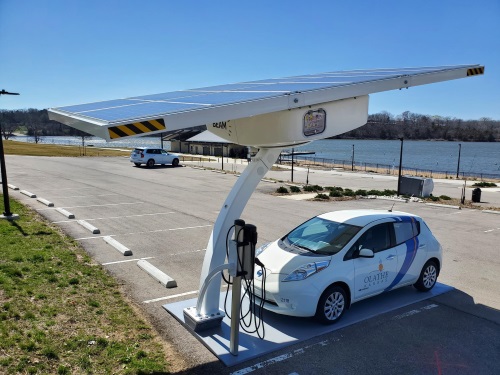FEDERAL ACTION
White House announces target of 20 percent aviation emissions reduction by 2030 – The Hill
Ida Damage Shows Need for Infrastructure Funding, Lawmakers Agree, But Divides Persist on Bills – AP
FAA Awards $100M to Develop Next Generation of Sustainable Aircraft Technology – FAA
Biden must appoint a climate justice champion to address fracked gas – The Hill (Opinion)
COVID-19
A Guide for Covid-19 Risk in Your County – New York Times
Pre-flight COVID testing drastically reduces risk of infection: study – The Hill
INFRASTRUCTURE RESILIENCE AND SUSTAINABILITY
Lake Mead corridor option removed as I-11 public meetings continue – Las Vegas Review-Journal
Massive rail project at Port of Long Beach remains stalled as officials wait for federal approval – Long Beach Post
A Climate-Friendly Shift In Transportation Planning Would Bring Economic Benefits Too, A New Report Says – Colorado Public Radio
AIR QUALITY
ETAP Podcast: Lower Rolling Resistance Cuts Emissions – AASHTO Journal
Report: CT not meeting emissions goals; Transportation to blame – Connecticut Mirror
Chevron to sell test batch of sustainable aviation fuel to Delta Air – Reuters
AG Healey Settles With School Bus Company Over Unnecessary Idling at New Bedford Schools; Launches Public Information Campaign to Curb Illegal Idling – Massachusetts Attorney General (Media release)
ENVIRONMENTAL JUSTICE
How Can Transit Deliver Urban Equity and Sustainability? – Government Technology
Black people are about to be swept aside for a South Carolina freeway – again – Washington Post
Matthew Tejada is keeping the EPA’s eyes on environmental justice – Grist
To Have or Have Not: When transformative mobility options are beyond the reach of underserved populations – Thinking Transportation podcast
NATURAL RESOURCES
Getting Manufacturers to Help Pay for Recycling – CityLab
Floating Wetlands Planned for Inner Harbor to Revive Urban Ecosystems, Clean Water – Maryland Matters
‘Sink this project’: Emails show concern of environmental review on machine-gun range – Cape Cod Times
CULTURAL RESOURCES
Lessons from the Rise and Fall of the Pedestrian Mall – CityLab
HEALTH AND HUMAN ENVIRONMENT/ACTIVE TRANSPORTATION
Scooter companies push back against proposed permit system in D.C. – Washington Post
UDOT grants Logan $4.1 million for pedestrian underpass – Herald Journal
Groundwork Jacksonville Breaks Ground On Emerald Trail – Resident Community News
Developers Offer Mobility Services to Lure Car-Free Renters – CityLab
Achieving sustainable cities: The link between Transit-Oriented Development (TOD) and road safety – MarketScreener
Pittsburgh Looks at New E-Scooter Rules After Complaints – Pittsburgh Post-Gazette
Exposure to traffic noise linked to higher dementia risk – British Medical Journal
Connecticut Launches Campaign to Alert Residents of New Pedestrian Laws – Connecticut DOT (Media release)
TRB RESOURCES/ANNOUNCEMENTS
Racial Equity Addendum to Critical Issues in Transportation – TRB
Predicting, Managing, and Preparing for Disasters Like Hurricane Ida – National Academies of Sciences, Engineering, and Medicine
FEDERAL REGISTER NOTICES
Notice of Competitive Offer for Solar Energy Development on Public Lands – Bureau of Land Management (Notice)
Port Access Route Study: Northern New York Bight – DHS (Notice of availability of draft report; reopening of the comment period)
Air Plan Limited Approval and Limited Disapproval, California; Mojave Desert Air Quality Management District – EPA (Final rule)
Board of Scientific Counselors (BOSC) Air Climate and Energy Subcommittee Meeting – October 2021 – EPA (Notice of public meeting)
FEMA’s Hazard Mitigation Assistance and Mitigation Planning Regulations – FEMA (Final rule)
FY 2021 American Rescue Plan Additional Assistance – FTA (Notice of Funding Opportunity)
Endangered Species Act, Marine Mammal Protection Act, and Wild Bird Protection Act; Receipt of Permit Applications – Fish and Wildlife Service (Notice of receipt of permit applications; request for comments)
Safety Program for Surface Mobile Equipment – Mine Safety and Health Administration (Proposed rule; request for comments)
Takes of Marine Mammals Incidental to Specified Activities; Taking Marine Mammals Incidental to the Berth III New Mooring Dolphins Project in Ketchikan, Alaska – NOAA (Notice; issuance of incidental harassment authorization)
Floating Cabins – Tennessee Valley Authority (Final rule)


